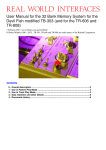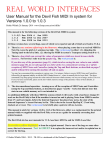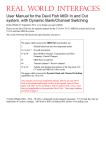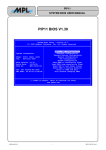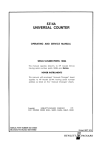Download User Manual for the 32 Bank Memory System for the Devil Fish
Transcript
User Manual for the 32 Bank Memory System for the
Devil Fish modified TB-303 (and the TR-606)
3 January 2010 www.firstpr.com.au/rwi/dfish/
© Robin Whittle 1996 – 2010. TB-303 and TR-606 are trade names of the Roland Corporation.
Overall description
This is an additional modification I can install in a Devil Fish modified TB-303 or in a TR606.
It provides 32 times the normal memory of the TB-303 or TR-606 – with the ability to
switch from one bank to another while a pattern is playing. This enables changes to the
notes played by the sequencer on a note-by-note basis, in contrast to the usual arrangement
by which the sequencer finishes one pattern before starting the next.
In the discussion which follows, the term "bank" refers to the total memory of a TB-303:
•
Four Pattern Groups (I, II, III, IV) each of 16 patterns, 1A - 8A, 1B - 8B.
•
7 Tracks (songs) numbered 1 to 7. (Actually 7 starting points in the long track
memory.)
(In the TR-606, a "bank" of memory consists of 32 patterns and 8 tracks.)
The system selects between the 32 banks with the position of five toggleswitches. There are
32 combinations of these five switches being either up or down. Four of the switches are in
a horizontal row. The fifth is below them, and is associated with a push-button switch which
reverses its function. The purpose of the push-button switch is to provide a convenient
instantaneous means of switching banks.
There is no labelling of the switches. Nor is there an particular numbering system for the
banks. Using a binary number system, the banks could be numbered as follows.
'v' and '^' refer to down and up states of the five switches. For instance the photograph
above shows the switches set for bank 4.
Switches
4 3210
Bank number
Switches Bank number
4 3210
v
v
v
v
v
v
v
v
vvvv
vvv^
vv^v
vv^^
v^vv
v^v^
v^^v
v^^^
0
1
2
3
4
5
6
7
^
^
^
^
^
^
^
^
vvvv
vvv^
vv^v
vv^^
v^vv
v^v^
v^^v
v^^^
16
17
18
19
20
21
22
23
v
v
v
v
v
v
v
v
^vvv
^vv^
^v^v
^v^^
^^vv
^^v^
^^^v
^^^^
8
9
10
11
12
13
14
15
^
^
^
^
^
^
^
^
^vvv
^vv^
^v^v
^v^^
^^vv
^^v^
^^^v
^^^^
24
25
26
27
28
29
30
31
For the fifth switch (labelled 4 in the table above), the state '^' is achieved with either:
1 - The toggleswitch up and the button not pressed.
or
2 - The toggleswitch down and the button pressed.
Use in Pattern Play Mode
If there is no need to switch banks while a pattern is playing, then operation is
straightforward. Simply select the desired memory bank with the toggleswitches and use the
machine normally.
Switching banks while the sequencer is playing patterns enables the creation in real-time of
novel combinations of notes. For instance the first half of a pattern in bank 8 could be
played, and then by moving the right switch to the up position, the rest of the notes in that
bar of music will come from a pattern in bank 9.
Each pattern contains the following information:
•
The length of the pattern in steps. This can be between 1 and 16, or 1 to 15 for triplet
mode. After clearing the pattern, hold down the Function button and press the "Step"
button "9" (the same as Transpose Down) once for each note you want in the pattern.
•
The "pre-scale", which is typically for 16 notes per 96 clock bar, but can be in triplet
mode for 12 notes per 96 clock bar. After clearing the pattern, it is in 1/16th note
mode, but by holding Function and pressing "0" the pattern is forever set to triplet
mode.
2
•
16 notes, each of which contains:
o
o
o
Pitch.
Accent on/off.
Slide on/off.
(For the TR-606, each pattern has 16 beats, each of which can have each drum sound and
accent programmed on or off.)
The sequencer is a single-chip CPU connected to what is normally a single bank of memory.
With the 32 bank modification, there are actually 32 banks of memory, and the CPU
accesses whichever one is currently selected by the toggleswitches. (The switches are debounced, so there are no messy transitions between banks due to mechanical bouncing of
switch contacts.)
When the machine starts playing a pattern, the sequencer software (which is permanently
built into the CPU) reads the length and pre-scale and stores these values in the CPU's
internal RAM. When it comes to play each note (for the TR-606, each beat), the sequencer
software causes the CPU to reads the external memory to retrieve the note, accent and slide
information for that note. (For the TR-606, the CPU reads which drums are to be triggered,
and whether accent is to be set from external memory just before playing each beat.)
Therefore, by switching to another bank of memory in the middle of a pattern, the sequencer
will play subsequent notes from the new memory bank. Switching will not change the note
currently being played, but affects all subsequent notes.
Here is a concrete example for the TB-303. The memory switches are set to ^ vv^v
which is Bank 18. The sequence is started playing Pattern 5B in Pattern Group III. Let's call
this "Pattern III-5B". The sequencer plays this pattern several times and then in the middle
of the pattern, while note 4 is playing, either the fifth toggleswitch ("4" in the above chart) is
lowered, or the pushbutton is pressed. Either action has the same effect of making the fifth
switch function as a "low". So the bank is now v vv^v – Bank 2. As the CPU prepares
to play the fifth note, it reads from memory, but instead of reading Note 5 of Bank 18's
Pattern III-5B, it reads Note 5 of Bank 2's Pattern III-5B. So the pitch, accent and slide will
vary as the banks are switched, but the CPU will take no notice of the lengths and pre-scales
of any of the patterns it is playing.
Switch banks whilst in Pattern Write mode will surely lead to confusion of both the
sequencer software and the user!
Use in Track Play Mode
When I first began modifying TB-303s, TR-606s and TR-808s in 1981/82 , it was to install
multiple memory banks. The purpose was to store more patterns and tracks so the users
could use the machines to accompany them on guitar, vocals, keyboards etc. Some of these
musicians had repertoires of hundreds of songs. In those systems I used push-button
switches, counters LEDs and/or 7 segment figure-8 LED displays to control and display the
current bank number. The memory system was designed to reset the CPU whenever the
bank was changed. Therefore changing from bank 23 to bank 13 was like turning off one
drum-machine or TB-303 and turning on another. This was necessary, since there were
certain items of data in the Track memory which was only read when the CPU ran its
initialisation routines after being reset. (In the case of the TR-808, I made this reset circuit
disableable to allow for live switching between banks in Pattern Play mode.)
3
Without this automatic reset circuit, there was a grave danger of the user changing banks
whilst the CPU was running, and so causing it to become confused – particularly in regard to
the starting and ending points of tracks and the prescales and lengths of patterns.
Now that the primary use of the TB-303 / Devil Fish (and the TR-606) is real-time
manipulation rather than playing songs reliably, I have changed the memory control system.
The new system has no automatic reset circuitry at all.
This toggleswitch and push-button arrangement is elegant, flexible and reliable. However, if
you are using Track Play mode and you switch banks whilst the machine is turned on, then it
is quite likely that the CPU's software will generate unexpected and undesirable results.
If you are using Track Play Mode, do not change banks while the machine is turned on.
If you accidentally do so, turn the machine off and on again so that the CPU reads in
crucial data from the current bank.
Unless you want to create unpredictable scrambles in the track memory, never change bank
while you are in Track Write mode!
Data retention and other details
This modification involves removing the existing memory chips and installing a much larger
capacity memory system. Therefore it is not possible to retain the machine's memory data.
Apart from a few test patterns I write into it, the modified machine will contain random data,
so be sure to clear each track before you start writing.
I have observed the TB-303's sequencer do some strange things, apparently with errant data
in the memory. I don't recall exactly what these things are, how to create the situation or
how to resolve it. Such strange states of data in certain patterns cannot be ruled out in any
TB-303, whether or not it has extra memory banks.
The current drawn by the memory system is still below 1uA, so all the statements in the
Devil Fish User Manual about data retention, Lithium Battery voltage measurement and life,
and clearing the memory apply to the new system.
The 32 bank memory system is covered by the same guarantee arrangements as the Devil
Fish mods.
It is possible to create an 8 bank system as well, but it is almost as much work and so would
cost only marginally less.
Note : I received reports from three users that the memory system may misbehave when the
machine is running from batteries alone. I have not been able to reproduce this. The
problem may be related to relatively high voltage fresh alkaline cells. Perhaps it would also
be a problem running from a power supply while high voltage batteries are installed.
Starting with Devil Fish serial number 081 (4 April 2000) I altered the battery supply
arrangements for the 32 bank memory system to avoid potential problems when C-cell
batteries are installed. This appears to have solved the problem.
4




